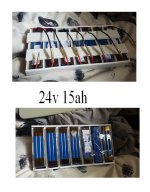whatever
100 kW
- Joined
- Jun 3, 2010
- Messages
- 1,297
so I did't own a car for over 10 years or so, used ebikes.
Now getting older and getting back in to ice vehicles.
I find that can bus is used to control just about everything in cars. I had no idea, didn't even know what
a can bus was. I was vaguely aware you could send multiple signals down wires. But now I see the
huge amount of data can be transmitted/recieved and used for control
The issue with ebikes is monitoring battery cells, its the black hole of information in electric cars and ebikes.
So how to monitor lots of cells is very much a work in progress for everyone.
I think can bus will move over to ebikes at least in some simple form, theres too many wires to use cell log type devices.
There would certainly be a market for a simple can bus setup for multiple lithium cells.
Anyhow.....there still remains the real black hole which is how to monitor multiple parallel cells, as far as i'm aware no-one is
doing it, not even tesla, from memory some modules have 23 cells or so in parallel and they are monitored as one cell, thats what
I call a black hole of intormation, the information is just not there, you can get some info from voltages and capacity to predict if there is a bad cell or three, but really there is no detailed monitoring of individual cells.
I often see people saying tesla monitors all the cells, but the reality they dont, no one does as far as I know.
Who will solve this problem ?
Now getting older and getting back in to ice vehicles.
I find that can bus is used to control just about everything in cars. I had no idea, didn't even know what
a can bus was. I was vaguely aware you could send multiple signals down wires. But now I see the
huge amount of data can be transmitted/recieved and used for control
The issue with ebikes is monitoring battery cells, its the black hole of information in electric cars and ebikes.
So how to monitor lots of cells is very much a work in progress for everyone.
I think can bus will move over to ebikes at least in some simple form, theres too many wires to use cell log type devices.
There would certainly be a market for a simple can bus setup for multiple lithium cells.
Anyhow.....there still remains the real black hole which is how to monitor multiple parallel cells, as far as i'm aware no-one is
doing it, not even tesla, from memory some modules have 23 cells or so in parallel and they are monitored as one cell, thats what
I call a black hole of intormation, the information is just not there, you can get some info from voltages and capacity to predict if there is a bad cell or three, but really there is no detailed monitoring of individual cells.
I often see people saying tesla monitors all the cells, but the reality they dont, no one does as far as I know.
Who will solve this problem ?


